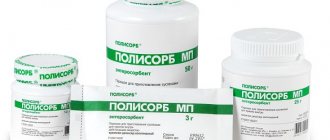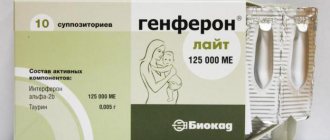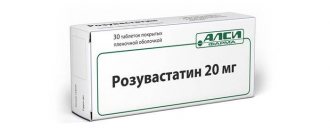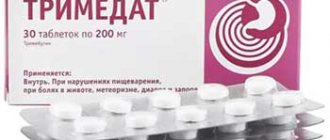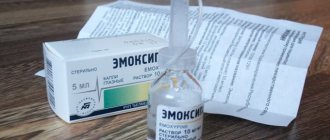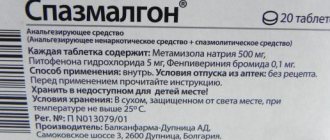Category: Published 02/17/2017 · Comments: · Reading time: 4 min · Views: 1,719
A medicinal product of completely natural origin that has pronounced antidiarrheal activity is the drug “Neosmectin”. What does this medicine help with? The powder can have an adsorbing effect. The drug “Neosmectin”, the instructions for use indicate this, has proven itself excellently in pediatric practice and in adult patients.
Release form and composition
Neosmectin powder is white with a yellow or gray tint; more intense coloring to a brownish-yellow color is allowed. The drug has the smell of vanillin. The main active ingredient of Neosmectin powder is dioctahedral smectite, its content in one sachet of the drug is 3 g. The drug also contains auxiliary components.
Neosmectin powder is contained in sachets of combined material in an amount of 3.76 g. A cardboard pack contains 1, 3, 5, 10, 30 or 50 sachets and instructions for the drug.
Side effects
If the dosage is followed and the medicinal emulsion is taken according to the instructions, negative manifestations occur in a minimal number of patients. Most complaints about side effects after using an antidiarrheal drug are associated with violation of the rules for taking the composition.
Some patients complain of the following body reactions:
- skin rashes, itching;
- constipation.
If side effects occur, you need to check whether the solution is prepared correctly and whether the one-time and daily dosage is not exceeded. If there are no violations, the medication is temporarily stopped and symptomatic treatment is carried out (sorbents, antihistamines, chamomile decoction).
Actions in case of overdose
No information has been provided on cases of overdose.
Contraindications
The drug Neosmectin has a gentle effect on the gastrointestinal tract and has a minimal list of restrictions. During the first appointment, the doctor finds out whether the patient has any contraindications for the use of the antidiarrheal composition.
The gastroenterologist prescribes another drug with a similar effect when identifying:
- hypersensitivity to dioctahedral smectite or auxiliary components;
- intestinal obstruction.
During pregnancy
The absence of toxic components and a delicate effect on organs and systems allows the drug Neosmectin to be used to eliminate problems with the stomach and intestines in expectant mothers.
Before using a product with a gastroprotective, antidiarrheal effect, a woman should consult a gynecologist and gastroenterologist to clarify the optimal daily dosage and duration of use for a particular disease or condition.
pharmachologic effect
Neosmectin is an effective antidiarrheal drug of natural origin that has an adsorbing effect. Application helps stabilize the mucous barrier, form polyvalent bonds with mucus glycoproteins, improve the gastroprotective properties of mucus (with respect to the action of bile salts, hydrochloric acid, microorganisms and their toxins), as well as increase the amount of mucus.
This agent has a selective sorption effect, which is due to the discoid-crystalline structure of the drug. At the same time, it adsorbs bacteria and viruses located in the lumen of the gastrointestinal tract. The drug, used in therapeutic doses, does not have a direct effect on intestinal motility.
PREGNANCY AND LACTATION
One of the mildest and most gentle drugs for the treatment of intestinal disorders in pregnant and lactating women, as well as in newborns. During the period of bearing a child, the mother’s body is weakened and very vulnerable; taking Smecta analogues can only aggravate the situation and cause stomach pain and loose stools.
During breastfeeding of a newborn, the drug does not enter the mother's milk, since it is not absorbed by the intestines. During pregnancy, women often experience problems with loose stools due to pressure on the intestines and an increase in the amount of waste and toxins entering the lower digestive tract. For this reason, part of the liquid from the stool is not absorbed, and it turns out half-formed. Smecta adsorbs excess fluid and toxins, promoting the formation of normal stool.
Instructions for use
Neosmectin is taken orally.
Adults and children over 12 years of age are prescribed 3 g (1 sachet) 3 times a day. The contents of the bag are dissolved in 100 ml of water, gradually adding the powder and stirring it evenly:
- for children under 12 years of age, the contents of the sachet are dissolved in 50 ml of liquid;
- children under 1 year of age are prescribed 3 g (1 sachet) per day;
- at the age of 1-2 years - 6 g (2 sachets) per day;
- over 2 years - 6-9 g (2-3 sachets) per day.
The daily dose is distributed into 3-4 doses during the day.
Indications for use
Gastroenterologists recommend using Neosmectin for acute diarrhea. The malaise can be of the following origin:
- Allergic. caused by food, medications, inhalation of toxic agents.
- Due to the use of antibiotics in the treatment of infectious diseases.
- Bacterial - diarrhea affecting the large and small intestines.
- Caused by poor nutrition and irregular eating patterns.
The absorbent is included in the therapeutic complex for diarrhea of infectious origin. When the intestines are disrupted, as a rule, a person feels heaviness in the stomach, he experiences heartburn and nausea. Neosmectin helps get rid of unpleasant symptoms. The drug suspension is prescribed for pathologies accompanied by bloating, flatulence, and nausea. The medicine is taken for heartburn caused by overeating or indigestion.
The powder is also prescribed to children from birth for diarrhea, nausea, and vomiting. The drug Neosmectin does not have a direct effect on intestinal motility and is suitable for eliminating the symptoms of an allergic reaction in infants.
If nutrition during pregnancy was not entirely correct, complications in the form of loose stools can be eliminated with the help of Neosmectin solution. It is necessary to start treatment only after consulting a doctor. The medicine helps well against diarrhea, but for pregnant women, excessive consolidation of the stool is undesirable.
Contraindications
According to the annotation, the use of Neosmectin is contraindicated in case of intestinal obstruction and hypersensitivity to the components of the drug. Patients with diabetes mellitus should also use the drug with caution due to the fact that it contains glucose monohydrate.
Since there is no information about the safe use of the medicine during breastfeeding and pregnancy, during these periods the medicine can be used only in extreme cases, under the supervision of a specialist.
Undesirable effects and contraindications
From the instructions included with each package of Neosmectin, it follows that the medication has a certain list of contraindications:
- a person has a tendency to constipation;
- formed intestinal obstruction;
- individual hypersensitivity to dioctahedral or other components of Neosmectin, which may result in side effects.
Relative contraindications include an unknown root cause of diarrhea, the period of gestation and subsequent lactation. In this case, only a specialist should decide whether to take Neosmectin powder.
Among the undesirable effects, based on patient reviews, one can indicate the appearance of persistent constipation while taking the medication, as well as the occurrence of allergic rashes on the skin. By lowering the dose of the drug or completely abandoning it, all of these undesirable effects disappear on their own.
special instructions
Before you start taking Neosmectin powder, you should carefully read the instructions for the drug; you need to pay attention to several special instructions regarding its use:
- There are currently no accurate data on the safety of the drug for pregnant women and the developing fetus.
- The drug does not affect the speed of psychomotor reactions and the ability to concentrate.
- The time interval between taking Neosmectin powder and drugs of other pharmacological groups should be at least 1 hour.
- 1 sachet of Neosmectin powder contains 0.06 XE (bread units) of glucose, which is important to consider for patients with concomitant diabetes mellitus.
- The resulting suspension, which is distributed into several doses during the day, should be stored in the refrigerator and should be shaken before use. The finished suspension should be used within a period of no more than 16 hours.
For children under 1 year of age, dissolve 1 sachet in a 50 ml bottle, then this volume of the resulting suspension is distributed into 3 doses during the day; if necessary, milk can be added to the solution.
Reviews
The effect of the drug is positively assessed by patients and doctors. Among the advantages: high efficiency, rapid elimination of diarrhea, reduction in the manifestations of flatulence, the possibility of use in infants and pregnant women. The drug Neosmectin has a minimum of restrictions and negative reactions. Many are attracted by the reasonable cost of an effective composition with a gastroprotective effect.
Instructions for use of the antidiarrheal drug Neosmectin are mandatory for all patients to study. The drug shows high effectiveness if the rules of administration are strictly followed, age, indications and contraindications are taken into account.
Analogues of the drug Neosmectin
Analogues are determined by structure:
- Loperamide.
- Nifuroxazide.
- Diosmectite.
- Enterofuril.
- Benta.
- Diosorb.
- Smecta.
- Dioctahedral smectite.
Which is better: Smecta or Neosmectin?
This question is often asked on specialized forums. At the same time, experts say that there are no special differences between these drugs, other than price and country of manufacture.
The basis of each of these medicines is dioctahedral smectite or diosmectite. Therefore, Smecta and Neosmectin are equally effective.
Powder "Neosmectin": what helps
Since the main mechanism of the pharmacological agent “Neosmetin” is aimed at correcting the negative condition in the rectal ampulla, therefore the main indications for its use are:
- diarrhea of allergic nature;
- intestinal disorders caused by taking certain subgroups of medications;
- nutritional variant of diarrhea - due to an uncorrected diet;
- loose stools as a symptom of an infectious pathology;
- debilitating heartburn and flatulence;
- pain impulses in various areas of the intestines - spasms.
By
Vacation conditions and price
The average cost of Neosmectin (3 g sachets, 10 pieces with raspberry or orange flavor) in Moscow is 135 rubles. The powder is sold in pharmacies as an over-the-counter drug. If you have any doubts or questions regarding its use, you should consult your doctor.
The shelf life of the powder is 4 years from the date of its manufacture. The instructions for use suggest storing Neosmectin in the original packaging, in a dark, dry place, out of reach of children, at an air temperature not exceeding +25° C.
Post Views: 175
Effective against diarrhea
The drug is used for allergic and drug-induced diarrhea, malnutrition or poisoning from spoiled food, as well as infections. The benefit of Neosmectin for diarrhea is that the medication helps with symptoms of bloating, heaviness in the abdomen and heartburn. It is also used in cases of various gastrointestinal pathologies (gastritis, reflux, duodenitis).
The use of the drug helps children with diarrhea due to the following effects:
- the medication helps remove viruses, toxins, bacteria and bile acids from the child’s body;
- increases the resistance of the intestinal and stomach mucous membranes to various damages;
- reduces gas formation, reducing the intensity of intestinal colic and spasms.
Neosmectin can be taken from the first month of the baby's life. However, you must first consult with your doctor and strictly follow the instructions.
The drug will also help with bloating
The dosage of Neosmectin for diarrhea in children is summarized in the table.
| Child's age | Drug dose |
| From birth to one year | One sachet (three grams) per day is prescribed. In this case, the powder is dissolved in a bottle with 50 milliliters of breast milk or other food (formula) and distributed into two or three doses. Diluted Neosmectin, as indicated in the instructions, can also be added to purees, tea or compote. Prepared but unused suspension must be stored in the refrigerator (no longer than 16 hours). Before use, the medicine taken out of the refrigerator should be slightly warmed by dipping the container in warm water, then shake thoroughly. |
| From one to two years | The daily dose is up to six grams of the drug (no more than two sachets). |
| From two to twelve years | Two to three sachets per day (up to nine grams). The suspension is distributed into three or four doses. |
| Over twelve years old | Three grams of the drug (one sachet) three times a day. One sachet of powder must be dissolved in 100 milliliters of water. In this case, you should pour out the medicine gradually, stirring the liquid. |
Read also: what to give to babies under one year old for diarrhea.
"Neosmectin" or "Smecta"?
This question can often be heard at pediatrician appointments or on Internet forums. According to reviews of experts, there are no special differences, except for the price and the country that produces these sorbents.
The main active ingredient in both drugs, as the instructions for use say, is dioctahedral smectite. Therefore, they have the same effectiveness and effect. These drugs help cope equally well with diarrhea in children, which is caused by irritation of the intestinal mucosa or poisoning.
If we talk about the cost of analogues, then “Neosmectin” is a domestically produced drug. Smecta is produced by a pharmaceutical company located in France, so when choosing, you can base your choice on price. If a package of a domestic sorbent containing 10 sachets weighing 3 g each costs about 120-130 rubles, then a foreign analogue costs a little more, 165-170 rubles.
Composition and active substance
Neosmectin contains:
powder for the preparation of suspension for oral administration [vanilla]: active substance: dioctahedral smectite – 3 g excipients: dextrose monohydrate (glucose monohydrate) – 0.749 g, sodium saccharinate (sodium saccharin) – 0.007 g, vanillin – 0.004 g
powder for the preparation of suspension for oral administration [orange]: active substance: dioctahedral smectite -3 g excipients: dextrose monohydrate (glucose monohydrate) -0.726 g, sodium saccharinate (sodium saccharin) -0.007 g, vanillin -0.004 g, orange flavor - 0.023 g
powder for the preparation of suspension for oral administration [lemon]: active substance: dioctahedral smectite – 3 g excipients: dextrose monohydrate (glucose monohydrate) – 0.726 g, sodium saccharinate (sodium saccharin) – 0.007 g, vanillin – 0.004 g, lemon flavoring – 0.023 g
powder for the preparation of suspension for oral administration [raspberry]: active substance: dioctahedral smectite -3 g excipients: dextrose monohydrate (glucose monohydrate) -0.726 g, sodium saccharinate (sodium saccharin) -0.007 g, vanillin -0.004 g, raspberry flavor - 0.023 g.
Indications for use
The doctor prescribes a medicine for the treatment of acute food poisoning.
Smecta accelerates the elimination of bacterial toxins. The drug also reduces nausea, vomiting and diarrhea. Food allergies are a common indication for medication. Taking Smecta leads to rapid elimination of the product from the human body. Timely use of the drug reduces the intensity of urticaria and other allergic rashes.
The medicine is used to relieve digestive disorders - bloating, nausea, diarrhea. Smecta relieves the listed symptoms and improves the patient’s overall well-being.
Attention! The use of Smecta is indicated only after consultation with your doctor. Possible contraindications.
The drug is used to treat pain due to peptic ulcers. The drug coats the mucous membrane of the digestive organs, reduces the irritating effect of hydrochloric acid.
During pregnancy, Smecta is used to relieve attacks of heartburn and sour belching. The described symptoms are associated with an enlarged uterus and its pressure on the stomach. The contents of the organ enter the esophagus and have an irritating effect on the mucous membrane.
The drug binds to hydrochloric acid, reducing its aggressive effect. The drug also coats the inner wall of the esophagus.
The medication is indicated for the treatment of chronic diarrhea. The pathology is observed in 4% of expectant mothers and is associated with changes in hormonal levels and disturbances in eating habits.
Comparison, differences, what and for whom is better to choose
It is impossible to say which of the drugs is better, since they do not have any fundamental difference, both cope with the assigned tasks perfectly. In addition to getting rid of diarrhea, they successfully fight against chronic, acute pathologies of the stomach, as well as unpleasant consequences after long-term use of medications. There are only minor differences between them, presented below.
The products in question are produced in different countries and differ in cost and flavor. The price of Neosmectin is about 130 rubles , it is available in raspberry, orange, and vanilla flavors. It is a domestic drug, which is not so widespread and is in slightly less demand compared to the second one.
The cost of Smecta is slightly more expensive - about 180 rubles per package, and there are only two flavors - orange and vanilla. Country of origin: France. It is very popular and occupies a leading place in the choice of remedies for diseases of the digestive tract.
When using any sorbents, you need to remember that they can absorb not only harmful, but also useful substances. Therefore, in the case of taking other medications, in order to avoid a decrease in their effectiveness, it is necessary to maintain an interval between doses of one and a half hours.
Medicine and healthComment
Analogs
In addition to Neosmectin, there is a fairly large list of drugs with similar effects, which a doctor can sometimes prescribe instead of Smecta.
Analogs include the following drugs:
- Polysorb;
- Diosmectite;
- Enterosgel;
- Atoksil and others.
The difference in action between them is not significant. Modern means that are more effective than activated carbon are increasingly being used to prevent and treat poisoning. You should not take Neosmectin, like any other analogue, at the same time as Smecta. Since this can lead to exceeding the dosage of adsorbents and cause constipation.
Treatment of diarrhea, heartburn and bloating can be carried out using one of the drugs: Neosmectin or Smecta. It should be borne in mind that Neosmectin cannot be used together with Smecta in the same course of treatment.
Side effects
Taking the medication is rarely accompanied by side effects.
In persons with a predisposition, Smecta causes delayed bowel movements. To prevent constipation, the expectant mother should drink at least 2 liters of water per day, eat raw vegetables or fiber. Very rarely, the use of the drug contributed to the development of hypersensitivity reactions. The allergy manifests itself as a rash like urticaria or angioedema.
Other side effects of taking the drug include:
- discomfort in the umbilical region;
- pain during bowel movements;
- constant feeling of thirst.
What is Neosmectin
The powder belongs to the group of antidiarrheal agents with a sorbing effect, which are used for indigestion of various etymologies. Diarrhea occurs due to the accumulation of excess fluid in the intestines, which is influenced by various factors. Neosmectin quickly collects and removes excess moisture, relieving the patient of the manifestations of the disease. The medicine also perfectly helps in the fight against viruses and pathogenic bacteria.
Related articles Vomiting with a hangover How to take Smecta for adults Laktozhinal side effects
To avoid negative consequences, it is important to coordinate the use of the sorbent with your doctor and read the instructions, which describe in detail how to use the powder for various gastrointestinal pathologies. By correctly using Neosmectin, the patient will not harm intestinal motility and will quickly receive the expected therapeutic effect. The effectiveness of the drug is ensured by its main active ingredient – dioctahedral smectite, which has the following properties:
- antidiarrheal (normalizes intestinal motility, stops diarrhea);
- adsorbent (removes toxins from the body, thereby improving the functioning of the gastrointestinal tract);
- gastroprotective (protects the digestive system from microbes and toxins, stabilizes the functioning of the gastrointestinal tract in case of poisoning);
- enveloping (has a beneficial effect on the condition of the intestinal mucosa, stomach, enveloping them, enhancing the protection of the membrane, relieving inflammation, preventing irritation of the walls of the organ due to food intake, other drugs, alcohol).
Composition and release form
The medicine is produced in the form of a powder for diluting a suspension intended for oral administration. Neosmectin has the appearance of a powdery mass of a grayish-yellowish-whitish color, with the taste of vanillin, lemon, orange or raspberry. The sorbent is sold in heat-sealed sachets of 3.76 g; a pack can contain 1, 3, 5, 10, 20 or 30 sachets. The composition of the product is presented in the table.
| Main component of the powder | Additional substances |
| Dioctahedral smectite (3 g) | Glucose monohydrate |
| Sodium saccharinate | |
| Flavor |
Pharmacological properties
The active substance of the powder is of natural origin and has the ability to adsorb harmful substances and excess liquid. Due to the dioxide-crystalline structure of the drug particles, it binds toxins, viruses, and bacteria on its surface. In addition, Neosmectin has the following therapeutic effects:
- forms polyvalent bonds with mucus glycoprotein molecules, thereby improving its protective properties;
- normalizes the mucous barrier of the walls of the hollow structures of the gastrointestinal tract;
- increases the volume of mucus produced, enhancing its gastroprotective effect;
- reduces the severity of diarrhea by reducing the concentration of toxins in the lumen of the hollow structures of the gastrointestinal tract.
What does Neosmectin help with?
In recommended therapeutic doses, the drug does not affect the intensity of intestinal motility. After taking Neosmectin orally in the form of a suspension, the active component does not enter the systemic circulation, is not metabolized and is removed unchanged through the rectum. Taking the medicine is indicated for the development of various gastrointestinal diseases, including:
- intestinal intoxication, which is accompanied by the development of diarrhea, accumulation of toxins in the lumen of the hollow structures of the digestive tract;
- food poisoning due to ingestion of poor quality food, which stimulated the development of dyspeptic syndrome and diarrhea;
- diarrhea resulting from an allergic reaction of the digestive system and as a result of taking other drugs.
In addition to the listed indications, the suspension is used to treat pathologies of the stomach or intestines (enteritis, gastritis, etc.), which are accompanied by flatulence, heartburn, and abdominal pain. The mixture is also taken in the complex treatment of various gastrointestinal pathologies, and it helps eliminate a number of unpleasant symptoms, including nausea, loose stools, pain, and a feeling of heaviness in the abdomen. Doctors can prescribe Neosmectin to treat the following gastrointestinal pathologies:
- gastroduodenitis;
- allergic diarrhea;
- disorders of the gastrointestinal tract of various nature, which are expressed by heartburn, heaviness in the abdomen, bloating, etc.;
- drug-induced diarrhea;
- loose stools due to malnutrition, consumption of poor quality food;
- peptic ulcer;
- various colitis.
Neosmectin during pregnancy
There is no reliable data on whether Neosmectin can be used by pregnant women or while breastfeeding, since such studies have not been conducted. Patients during pregnancy or lactation should consult their doctor before taking the drug. Despite the fact that Neosmectin is not absorbed by the intestines and works locally without affecting the child, there is a risk of developing constipation. This occurs due to a decrease in the amount of fluid in the intestines. To avoid this, it is important to drink plenty of fluids when taking the powder.
Characteristics of Smecta
This is a drug with adsorbent and antidiarrheal action. It is produced in the form of a powder with a faint vanilla odor, from which a suspension is prepared. It is packaged in laminated bags. The main component of the drug is dioctahedral smectite.
The medication in the intestines helps bind fungi, viruses, pathogenic bacteria and toxic substances, retains and removes along with feces. Thanks to this quality, Smecta is prescribed for various poisonings and diarrhea caused by intestinal infections or other reasons. In addition, for diseases of internal organs, it reduces the symptoms of intoxication.
Smecta is a drug with adsorbent and antidiarrheal action.
The drug helps to remove only pathogenic microorganisms and toxic substances. However, it does not capture nutrients, minerals, or vitamins.
The suspension has gastroprotective and enveloping properties, covering the surface of the mucous membrane of the gastrointestinal tract with a thin layer. This helps protect the stomach and intestines from injury. The adverse effects on the mucous membrane of these organs of bile acids, hydrochloric acid, microbes and toxins that they produce are neutralized. Smecta does not disrupt the normal functioning of the intestines, which does not lead to constipation or diarrhea.
The medication is prescribed for the following pathologies:
- diarrhea caused by allergies, medications, intestinal infections, and also resulting from non-compliance with the diet after eating low-quality food;
- intestinal colic;
- food poisoning;
- abdominal pain, flatulence, heartburn that appears due to diseases of the intestines, stomach, esophagus.
The medicine is dissolved in water before use. It is intended for both adults and children.
Smecta is prescribed for diarrhea of various etiologies.
Food poisoning is an indication for taking Smecta.
Indications for taking Smecta are abdominal pain, flatulence and heartburn.
Contraindications:
- glucose-galactose malabsorption syndrome;
- fructose intolerance;
- intestinal obstruction;
- excessive sensitivity to the components of the product;
- sucrose-isomaltase deficiency.
Taking Smecta can lead to the development of side effects:
- vomit;
- bloating;
- constipation;
- allergic reactions - skin itching, rash, urticaria, Quincke's edema.
It is allowed to use the drug during pregnancy and breastfeeding.
This is an adsorbent drug. Its main component is dioctahedral smectite. The medicine is produced in the form of a powder that has different flavors, from which a suspension is prepared. Its main purpose is the treatment of diarrhea of various origins.
Neosmectin is an adsorbent drug.
The drug increases the amount of mucus and normalizes the mucous barrier in the gastrointestinal tract. Thanks to the active component, a rapid antidiarrheal effect is achieved. The use of the medication does not affect the functioning of the intestines.
The medicine is indicated in the following cases:
- diarrhea, which occurs due to the accumulation of toxins in the gastrointestinal tract and infectious intestinal pathology;
- diarrhea resulting from allergies to certain foods and medications;
- food poisoning accompanied by diarrhea and bloating.
Neosmectin can be used in the complex treatment of infectious diarrhea, ulcers, colitis, enteritis and other diseases of the gastrointestinal tract, in which belching, heartburn, abdominal pain and bloating are observed.
Contraindications include:
- constipation, intestinal obstruction;
- diabetes;
- individual intolerance to the components of the medication.
The medication is not absorbed into the blood, so its use during pregnancy and breastfeeding is acceptable.
Constipation may occur while taking Neosmectin. In this case, reduce the dose of the drug. In addition, allergic reactions often develop. Because of this, you need to stop taking the suspension.
Smecta and Neosmectin are allowed to be used during pregnancy and breastfeeding.
Enterosorbents differ in price. Smecta costs about 170 rubles. Neosmectin is a little cheaper - 130 rubles. In addition, the first product is available in two flavors - orange and vanilla, and the second - in three (raspberry, vanilla and orange).
What do drugs have in common?
Both products are classified as adsorbents and antidiarrheal drugs. They have the same basic component. They contain additives to improve taste:
- vanillin;
- glucose;
- sodium saccharinate;
- flavorings.
Smecta and Neosmectin have the same indications for use and prohibitions for use.
Both medications can cause side effects such as constipation. Medicines contain sugar, so patients with diabetes should take them after consulting a doctor. They can be taken during pregnancy and breastfeeding. They are available in powder form, which must be dissolved in water before use. The course of treatment is 3-7 days.
Comparative characteristics of drugs
| Comparison parameter | Neosmectin | Smecta |
| Active substance | Diosmectite | |
| Manufacturer country | Russia | France |
| Company manufacturer | JSC Leksredstva Pharmstandard | Ipsen Pharma |
| Use for diabetes | Only after medical consultation | |
| Use during pregnancy | Yes | Yes |
| Use during breastfeeding | Yes | Yes |
| Release form | Powder for preparing suspension | |
| Amount of active ingredient per sachet, grams | 3 | 3 |
| Price for 10 sachets, rub. | From 140 | From 160 |
| Flavoring additives | Orange Raspberries Vanilla | Vanilla Orange |
| Antidiarrheal action | Yes | Yes |
| Contraindications for use | Individual intolerance to components and intolerance to sugars | |
| Patient age restrictions | No | No |
Neosmectin price
The sorbent can be found in any pharmacy in the capital and other cities of Russia, and its cost may vary depending on the dosage, the number of sachets in the package, and the pricing policy of a particular pharmacy. Average price of Neosmectin in Moscow:
| Dosage | Cost, rubles |
| 3 g, 10 sachets, vanilla flavor | 115 |
| 3 g, 10 sachets, orange flavor | 120 |
| 3 g, 30 sachets, vanilla flavor | 295-350 |
| 3 g, 1 sachet, any flavor | 20-25 |

